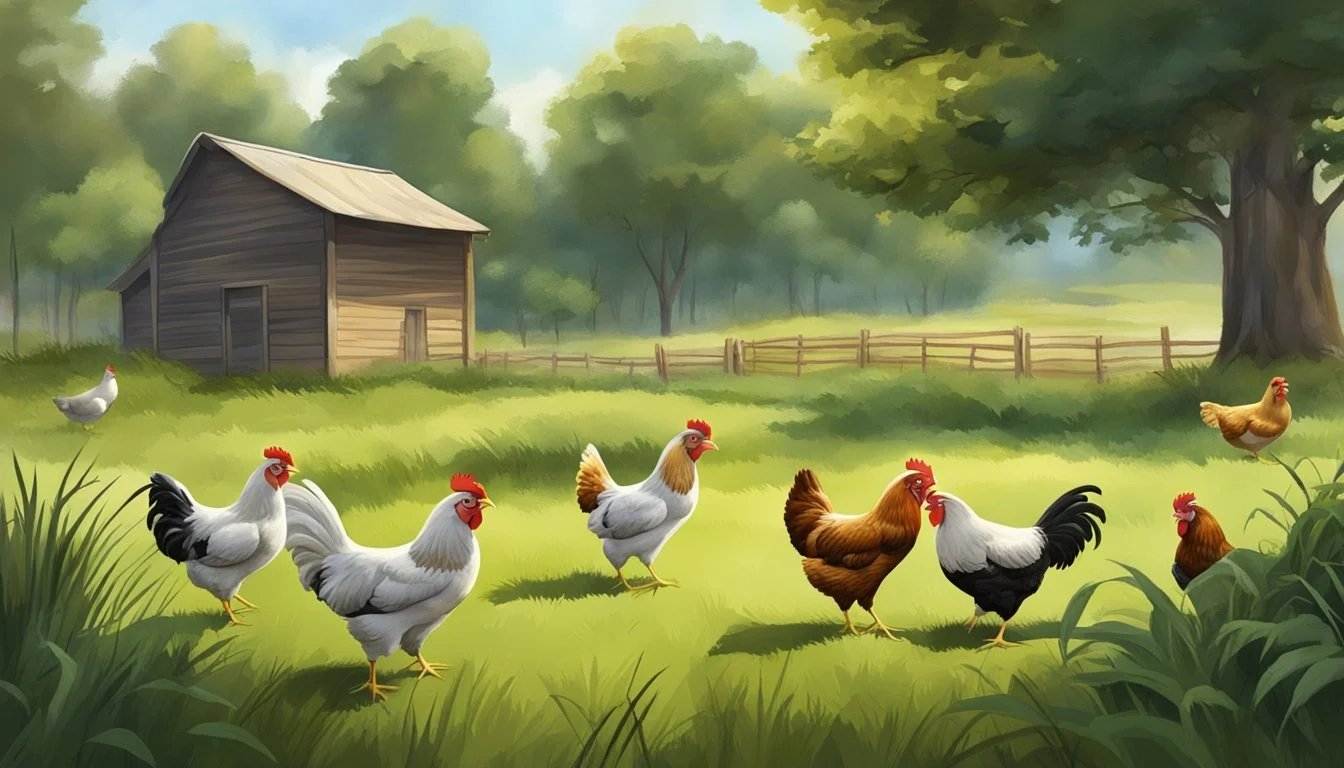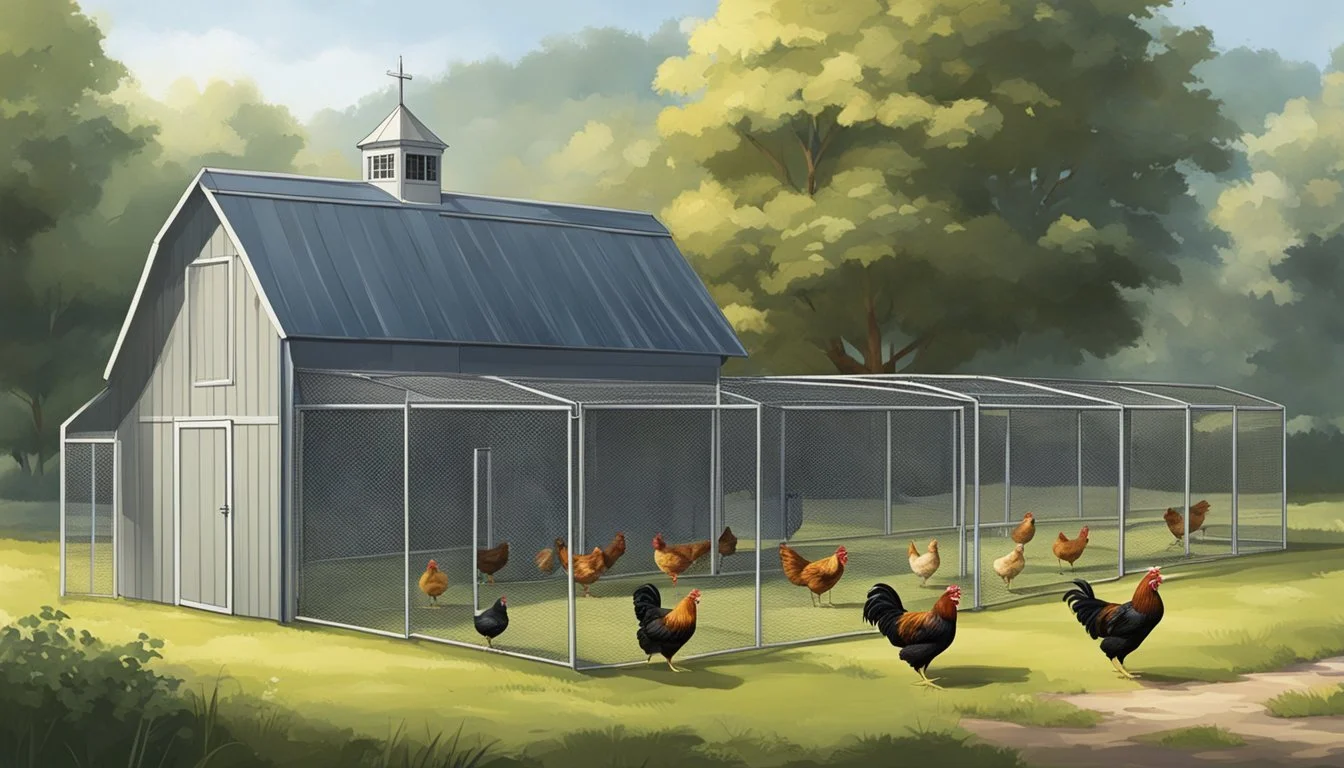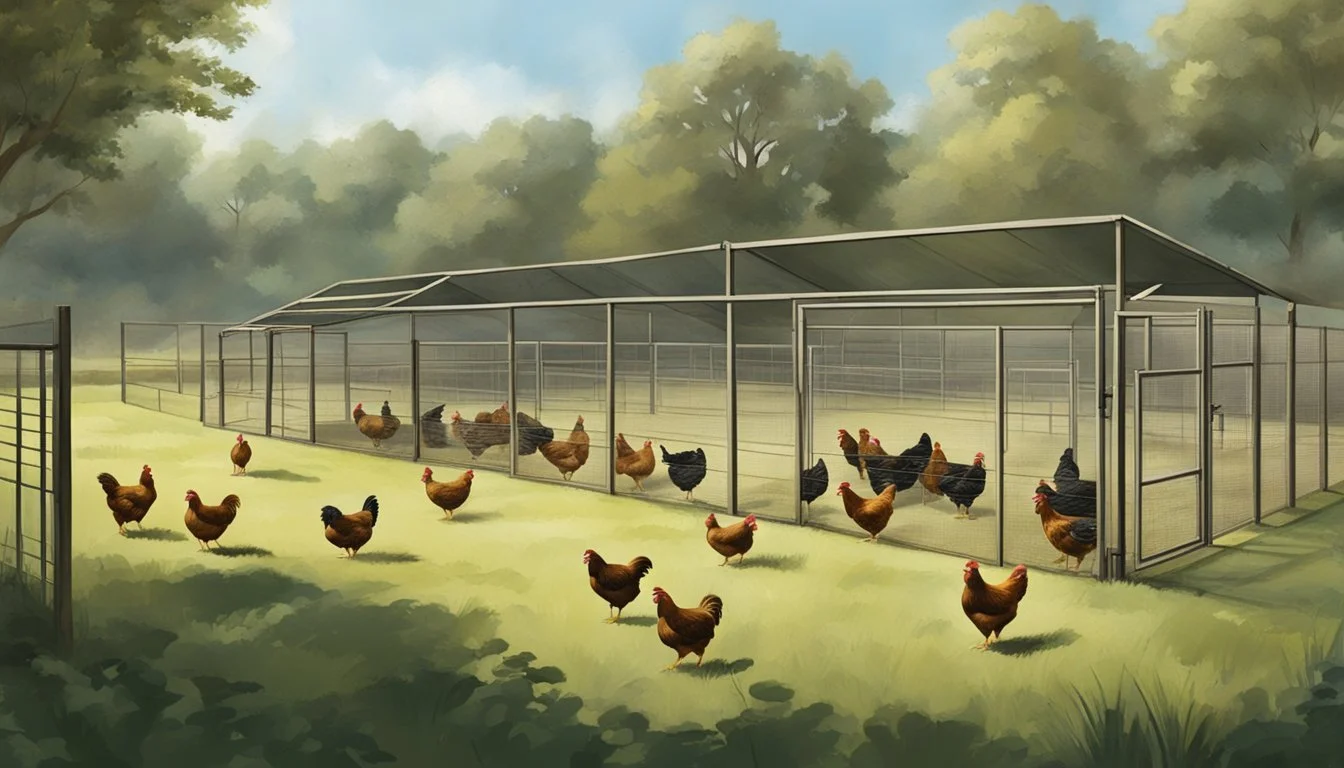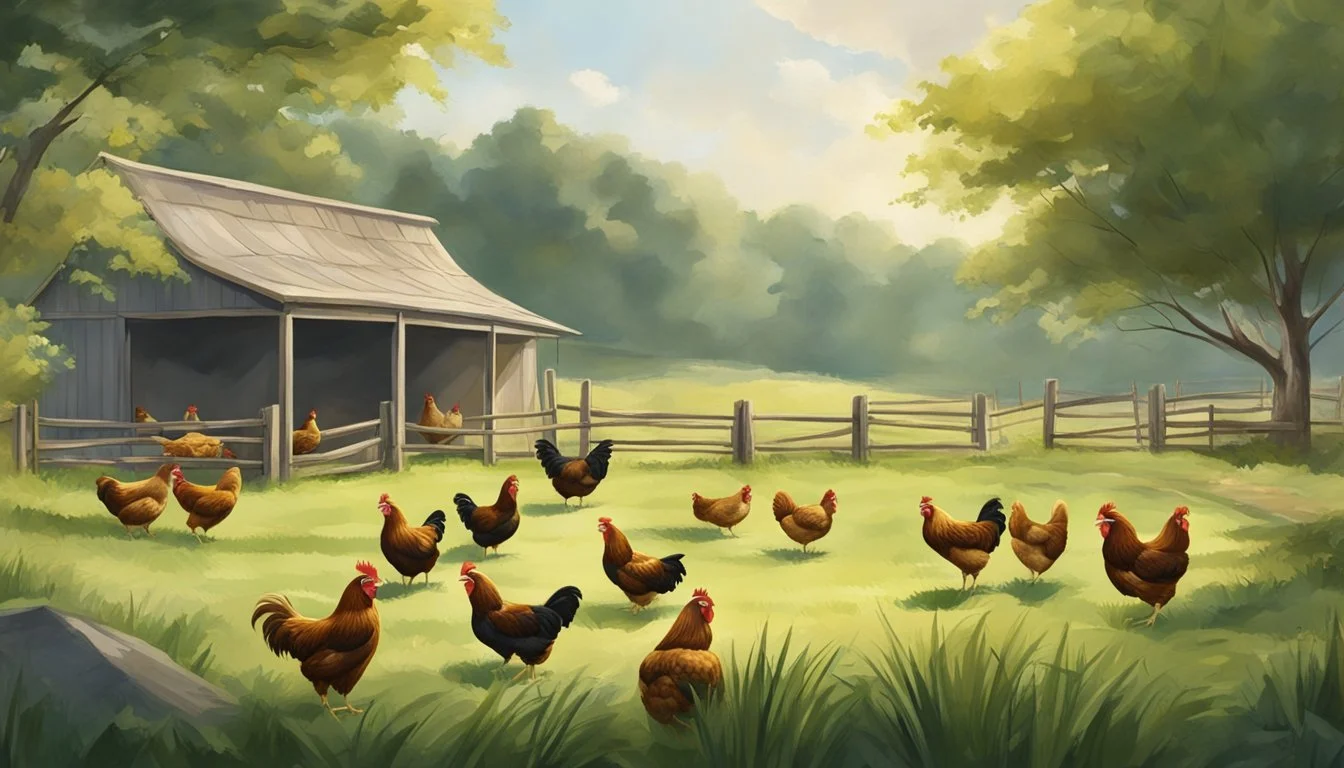What Are the Best Practices for Pasturing Chickens
Key Strategies for Healthy Flocks
Pasturing chickens has become an increasingly popular method for poultry farming, prioritizing the health and welfare of the birds while seeking to produce high-quality eggs and meat. The practice involves allowing chickens to roam on grassy fields, benefitting from natural forage and exercise, which can result in a more sustainable and ethical approach to poultry production. By grazing on pasture, chickens exhibit natural behaviors, which are essential for their well-being, and in return, they offer healthier and tastier products for the consumer.
Effective management of pastured poultry requires a careful balance of providing access to grass and the implementation of frequent rotation or movement to maintain the pasture's condition. These strategies not only prevent overgrazing and soil erosion but also minimize the risk of disease. Furthermore, as chickens scratch and peck at the ground, they contribute to a cyclical environmental benefit by aerating the soil and providing natural fertilization. Raising chickens on pasture is a holistic approach that considers not just the final products but the overall ecological impact and the quality of life for the poultry.
Shelter is a crucial component for pastured chickens to protect them from the elements and predators. Providing adequate housing ensures the flock's safety and comfort, which is vital for their ability to thrive. It also allows for egg-laying hens to have a secure place to nest and for all birds to seek refuge during adverse weather conditions. Producers of pasture-raised poultry must also consider local climate variables and predator pressures when designing their pasturing systems to ensure the highest standards of animal welfare and operational efficiency.
Understanding Pasture-Raised Poultry
Pasture-raised poultry epitomizes a method that prioritizes animal welfare, environmental health, and nutritional benefits. This approach to raising chickens involves more than just outdoor access; it embodies a philosophy and a set of practices that distinguish it from conventional methods.
Definitions and Benefits
Pastured poultry refers to chickens that are raised on a pasture, where they can forage for their natural diet, which includes insects, grass, and seeds. This system benefits the chicken's health and welfare by providing ample space to roam, fresh air, and exposure to sunlight. An environment rich in green grass contributes not only to the physical well-being of the chickens but also to the nutritional quality of their meat and eggs, which are often higher in omega-3 fatty acids and vitamins. Importantly, pastured poultry practices are more sustainable and have a reduced impact on the environment due to improved soil conditions and biodiversity.
Pastured Poultry vs. Free Range
While "free range" may suggest a certain level of outdoor access, there are no strict requirements for the amount of time the poultry must spend outside or the quality of the land they access. In contrast, pasture raised implies that chickens have continuous access to a pasture for a significant part of their life. Pastured poultry can scratch and peck at the ground, allowing their natural behaviors to flourish, which is pivotal for their welfare and also promotes ecological balance by aerating the soil and aiding in pest control.
History and Philosophy
The practice of raising poultry on pasture stems from traditional farming methods, predating the advent of industrial agriculture. The philosophy behind pastured poultry harks back to an era when sustainable farming integrated livestock into a holistic approach to land management. This method respects the natural behaviors of chickens and the ecological symbiosis between the pasture and the poultry. It encourages a humane approach to poultry production, emphasizing health, nutrition, and the overall quality of life for the birds, along with stewardship of the land.
Preparation of Pasture
Proper preparation of pasture is crucial for the health and productivity of chickens. Attention must be paid to selecting appropriate land, choosing diverse grasses and plants, and managing soil fertility to ensure a sustainable pasture system.
Selecting the Right Pastureland
When selecting pastureland, one must consider the land’s topography and drainage capabilities. Ideal pastureland has slight sloping to prevent water stagnation and minimize erosion, yet flat enough to allow chickens to roam comfortably. It should also have adequate sunlight and access to shade for the wellbeing of the flock.
Grass and Plant Types
The pasture should have a variety of plant species to provide chickens with a range of nutritional options. Legumes and grasses are particularly beneficial as they offer seeds and insects which are essential to poultry diets. Additionally, a diverse vegetation supports biodiversity, leading to a healthier ecosystem within the pasture.
Soil Fertility and Management
Maintaining soil fertility is paramount. Regular testing for nitrogen, phosphorus, and other nutrient levels informs necessary adjustments such as manure application or supplemental feeding. Effective fertility management ensures rich soil, leading to robust plant growth and minimal erosion. Proper fertilization, along with good pasture maintenance, forms the foundation for sustainable poultry foraging.
Chicken Health and Nutrition
When considering pastured poultry, it's critical to understand the dietary needs which influence chicken health, along with how natural behaviors like foraging contribute to their overall nutrition.
Nutritional Requirements
Chickens require a balanced diet rich in vitamins and minerals to maintain good health. A nutrient-dense diet for chickens typically includes a mix of proteins, carbohydrates, fats, vitamins, such as Vitamin A, and minerals. Proteins are often sourced from insects and seeds found during natural foraging. For pastured chickens, the variety of plants they consume also plays a significant role in their nutritional intake.
Common Health Concerns
Pastured poultry are at risk of parasites and diseases that can be mitigated through appropriate flock management. Overuse of antibiotics in poultry can lead to resistant strains of disease, therefore preventive health measures such as rotating pastures and supplementing with nutrient-dense feed are recommended to maintain flock health. Ensuring chickens have enough space reduces stress and the spread of disease.
Natural Foraging Behavior
Chickens naturally exhibit behaviors such as scratching and pecking as they forage for food. In a pastured environment, they have the opportunity to eat a diverse range of natural foods like insects, which are high in proteins, and grasses or seeds free from pesticides. This not only supports their nutritional needs but also keeps them active and healthy. Observing chickens' foraging behavior can also provide insight into whether their dietary needs are being met.
Chicken Breeds and Selection
Selecting the appropriate breed is crucial for the success of pasturing chickens. It's important to consider the breed's suitability for foraging, disease resistance, and overall adaptability to the pastured environment.
Layer, Broiler, and Dual-Purpose Breeds
Layers: Breeds like the Australorp are known for their proficient egg-laying abilities. These breeds are ideal if the primary goal is to produce eggs.
Broilers: Specifically bred for meat production, Cornish Cross chickens grow rapidly and have a high feed conversion rate, making them suitable as broilers.
Dual-Purpose: Breeds such as the Plymouth Rock and Delaware serve well for both egg and meat production, offering a balanced option for a pastured flock.
Breed Characteristics
Foraging Skills: Chickens that display strong foraging behavior, such as the Sussex, contribute to the success of pastured poultry by reducing feed costs and improving the quality of the land. Temperament: A calm and adaptable temperament, often found in breeds like the Australorp, helps in maintaining a cohesive flock dynamic. Climate Resilience: Certain breeds are better suited to specific climates, with some, like the Plymouth Rock, known for their hardiness in various conditions.
Genetic Considerations
Breeds should be chosen not only for their physical characteristics but also for their genetic diversity to ensure a robust and healthy flock. Selective breeding practices can enhance desirable traits such as growth rate in Cornish Cross, or the speckled egg color found in certain breeds. Genetic considerations help maintain a viable flock over multiple generations.
Housing and Protection
Ensuring the safety and comfort of a pastured flock necessitates adequate housing and protection strategies. These measures are crucial in safeguarding the chickens from predators and extreme weather, while also providing them with the necessary space to roam and express natural behaviors.
Chicken Tractors and Mobile Units
Chicken tractors offer an effective solution for pasture-raised poultry, allowing for the regular movement of the flock to fresh areas. This rotation prevents overgrazing and lessens the buildup of parasites in one spot. Typically, a chicken tractor is a floorless, mobile unit that confines chickens while still granting them access to fresh grass and soil. They come in various sizes and should be moved daily to maintain health and land quality.
Predator Deterrence
Predators pose a significant threat to poultry flocks, which makes deterrence a critical aspect of their housing. Robust fencing is essential, preferably with hardware cloth or electric net fencing, which can be used effectively in pastured settings. Additionally, guardians such as dogs, geese, or donkeys can be integrated as live deterrents. The use of visual deterrents like reflective tape or fake predators can also complement these measures, creating a multipronged defense strategy.
Shelter Requirements
Shelter is vital in protecting the flock from weather elements and providing a sense of security. Shelters should be sturdy, well-ventilated, and provide ample space for the chickens to roost and lay eggs. They must be designed to offer shade during hot weather and insulation against cold winds. An ideal outdoor space should allow chickens to exhibit natural behaviors while offering sufficient protection from rain, snow, or intense sunlight.
Managing the Flock on Pasture
Effective pasture management is crucial for the health and productivity of a poultry flock. Properly executed strategies can ensure optimal grazing, enhance the welfare of the animals, and maintain the longevity of the pasture.
Rotational Grazing
Rotational grazing is a systematic approach to grazing where chickens are moved to fresh pasture areas regularly. This method allows the grass time to recover and can lead to a healthier flock and richer soil. During the growing season, poultry should be rotated every one to three days, depending on pasture size and flock density, which encourages uniform grazing and reduces the buildup of parasites and diseases.
Integration with Other Livestock
Integrating poultry with other livestock, such as cattle or sheep, can maximize pasture usage and benefit all animals involved. Chickens often follow cattle in a practice known as 'leader-follower grazing,' where they consume insects and parasites that might otherwise harm the larger livestock, aiding in the overall management and health of the pasture.
Flock Monitoring and Care
The regular monitoring of the flock's health is vital to maintain high welfare standards. This includes checking for any signs of illness or injury, ensuring that they have access to clean water and supplemental feed as necessary, and making seasonal adjustments to the flock's care. For example, providing shade during hotter months and windbreaks during colder periods supports the well-being of the chickens through various seasons.
Economic and Business Considerations
Navigating the economic landscape and business strategies is crucial for farmers who engage in pasturing chickens. From initial investments to sustainable practices, the profitability of such an operation hinges on strategic planning and sound financial decisions.
Costs and Investments
Farmers must consider the initial costs associated with starting a pastured poultry operation, which include purchasing chicks, constructing brooders, and acquiring appropriate feeders and waterers. Investment in proper fencing and shelters that protect against predators is also vital. For poultry nutrition, sourcing balanced diets consisting of free range foraging options supplemented with organic grain can influence the health of the flock and, consequently, the quality of the produced meat or eggs.
Initial Expenses:
Chicks/Pullets
Housing and Brooding Equipment
Fencing and Predator Protection
Feed (e.g., Organic Grain)
Marketing and Sales Strategies
To achieve business success in pastured poultry, understanding direct marketing to consumers is fundamental. Farmers can leverage the storytelling aspect of regenerative agricultural practices and the premium value of pasture-raised chicken to establish a strong market presence. Emphasizing the health benefits of a balanced diet that pasture-raised birds receive can justify a higher retail price. Egg collection and packaging also add to the appeal for customers seeking transparency in their food sources.
Direct Marketing Components:
Branding and Storytelling
Transparent Product Labelling
Premium Pricing for Quality
Sustainability and Profitability
The choice to pursue slower-growing breeds and to implement free-range practices demonstrates a commitment to sustainability which can elevate the farm's profile. Influential figures such as Joel Salatin have shown that while this may involve higher initial expenses, it can also lead to long-term profitability through increased demand and customer loyalty. Additionally, aligning sales strategies with ethical farming, including mindful turkey integration and maintenance of pastures, ensures the financial viability of the farm.
Long-term Financial Goals:
Ethical Farming Practices
Higher Demand for Quality Products
Customer Loyalty and Retention
Seasonal and Environmental Challenges
Pasturing chickens requires a deep understanding of the environment to keep the flock healthy throughout the year. This includes adapting to the weather and climate, managing pests and weeds without compromising animal welfare or soil integrity, and maintaining long-term pasture health for sustainable homesteading.
Weather and Climate Adaptations
Adapting to changes in weather and climate is crucial for the welfare of pastured poultry. During the harsh winter months, providing adequate shelter to protect chickens from the cold and frozen conditions is imperative. Farmers may use mobile coops to allow for flexibility in location, ensuring chickens have access to well-drained land and are not exposed to harsh elements.
Managing Pests and Weeds
In an effort to maintain humane and eco-friendly practices, farmers avoid synthetic pesticides to control pests and weeds. They incorporate strategies like rotating pastures and promoting predator-friendly habitats to naturally reduce the pest population. Strategic plantings can also suppress weeds and contribute to a balanced ecosystem on the farm.
Long-Term Pasture Health
Ensuring the health of the pasture is a long-term commitment that directly impacts the viability of a pastured poultry operation. Regular soil testing helps in tailoring nutrient management, while controlled stocking densities prevent overgrazing and allow pastures to recover. Intentional rest periods for the land during off-seasons ensure the environment remains productive and supportive of the chickens' needs.
Practical Tips for Raising Chickens on Pasture
Successfully raising chickens on pasture requires diligent management and innovative practices. Establishing a daily routine, being prepared to troubleshoot common problems, and employing creative pasturing techniques are crucial for a thriving flock.
Daily Routine and Tasks
A structured daily routine is essential for the well-being of pasture-raised chickens. Morning checks should include ensuring the flock has access to clean water and a diverse range of forage to promote healthy scratching and foraging behavior. Regular relocation of coops or fencing can prevent overgrazing and encourage the natural regeneration of pastures. Evening tasks focus on securing the chickens from predators and checking for any signs of distress or illness.
Morning:
Check and refill water containers
Assess pasture condition and forage availability
Plan coop or fencing relocations if needed
Evening:
Count and secure chickens in their coops
Inspect for health issues
Prepare for the next day's pasture rotation if applicable
Troubleshooting Common Problems
When chickens are pastured, they may encounter issues such as predation, disease, or forage shortages that require swift intervention. Adequate fencing, both stationary and electric, can deter predators, while maintaining a clean environment will help prevent the spread of disease. During times when natural forage is insufficient, supplemental feed should be provided to ensure the chickens' dietary needs are met.
Predator Control:
Regularly inspect and repair fencing
Introduce guardian animals if necessary
Health Monitoring:
Observe for abnormal behavior or symptoms
Implement biosecurity measures to reduce disease spread
Innovative Practices in Pasturing
To support a sustainable and productive pasturing system, innovative practices such as rotational grazing can significantly benefit the land and the chickens. This involves moving the flock to fresh pasture regularly, allowing for regrowth and minimizing the buildup of waste. Some homesteads integrate chickens into a larger agro-ecosystem, where they aid in breaking down cellulose and controlling pests within crop rotations.
Rotational Grazing:
Divide pasture into segments for systematic grazing
Allow rest periods for pasture recovery
Integrated Systems:
Incorporate chickens into orchards or crop fields
Utilize chickens for natural pest management and fertilization
By following these practical tips and being attentive to the specific needs of the flock, those managing pasture poultry can expect healthier chickens and more robust pasture ecosystems.
Ethics and Animal Welfare
The ethics of animal welfare in pasturing chickens revolve around humane treatment, welfare considerations specific to pasture systems, and adherence to set regulations and certifications.
Humane Treatment Principles
Humane treatment of chickens entails providing living conditions where the birds can express natural behaviors. This includes allowing chickens access to outdoor spaces where they can forage, dust bathe, and have sufficient space to move freely. Producers should ensure shelter from predators and extreme weather conditions, contributing to the well-being of the animals.
Welfare Considerations in Pasture Systems
When considering the welfare of the animals in pasture systems, it's necessary to address the quality of the outdoor environment. This consists of maintaining pasture quality to prevent overgrazing, providing access to fresh water, and ensuring a varied diet to meet nutritional needs. Welfare also encompasses regular health monitoring to promptly manage any illnesses or injuries.
Regulations and Certifications
There are various regulations and certifications in place that aim to standardize the humane treatment of pastured chickens. These may include organic certifications and animal welfare standards like those from the Global Animal Partnership. Adherence to these guidelines reassures consumers that the chickens have been raised following high welfare and ethical standards.
End-of-Life Management
When managing a pastured chicken operation, understanding the intricacies of end-of-life management is crucial for ethical practices and quality product output. This includes not only the butchering and harvesting processes but also how to handle meat and eggs post-processing to ensure the final product meets high standards.
Harvesting and Butchering Best Practices
Proper harvesting and butchering are essential to ensure the welfare of chickens and the quality of meat. Freedom Rangers, a breed known for their meat, require careful handling to minimize stress and the potential for meat quality degradation before butchering. It is important to adhere to humane slaughtering guidelines which dictate that birds should be calmly confined and swiftly processed.
Processing for Meat and Eggs
Once chickens are humanely harvested, processing meat and eggs promptly and hygienically is key to safety and quality. Meat should be chilled quickly to reduce the growth of bacteria. Eggs must be collected regularly, cleaned, and stored at appropriate temperatures to maintain freshness and minimize the risk of salmonella contamination.
Final Product Quality
Attention to detail in the processing phase greatly influences the final quality of chicken products. The meat must be inspected for abnormalities, and aging can improve tenderness and flavor. Proper packaging is also critical for both meat and eggs to protect against contamination and ensure consumers receive the products in the best possible condition.





